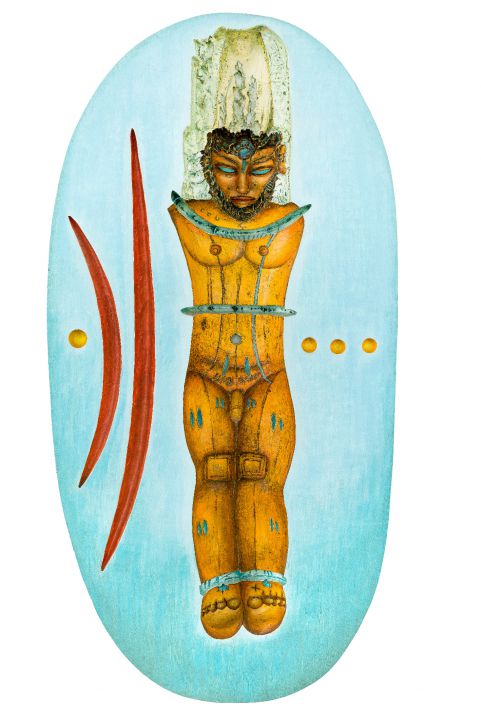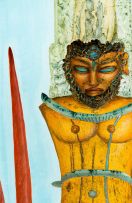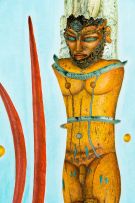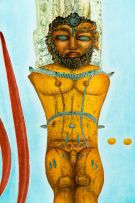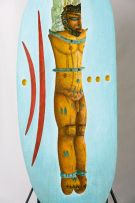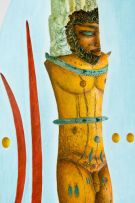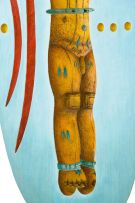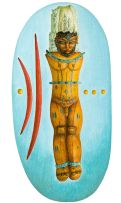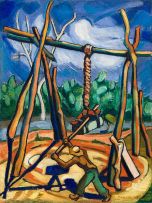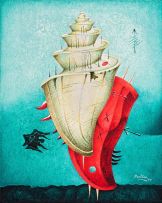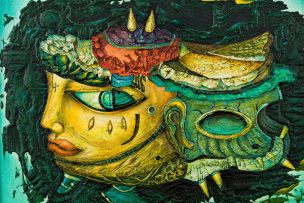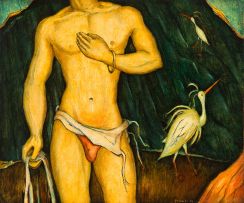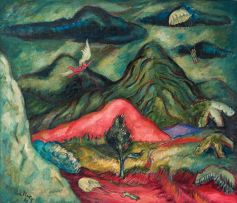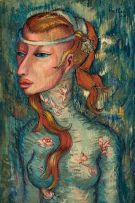Important South African and International Art
Live Auction, 7 November 2016
Evening Sale
Incl. Buyer's Premium & VAT
About this Item
signed and dated 1969
Notes
Alexis Preller's Adam, made in 1969, is a powerful, enigmatic work of immense complexity. It holds a pivotal place in his complex oeuvre, engaging the intersection of mythology and the human body.
In 2009, at the time of publishing the comprehensive Alexis Preller: Africa, the Sun and Shadows and Alexis Preller: Collected Images, the whereabouts of this major work was unknown. Nevertheless, because it was seen as so important, the work was reproduced in the books in black and white from the only extant photograph, which had appeared in the October 1969 issue of Artlook magazine, just prior to the artist's groundbreaking exhibition of intaglios in the same year at the Lidchi Art Gallery, Johannesburg. Esmé Berman holds this work in such high esteem that she devoted a four-page spread to the analysis of this Adam. The work has only recently come to light in New York and has returned to South Africa to come up for sale, and for us to view it for the first time in many years.
This work is an almost life-size rendition of Adam, and is executed in Preller's innovative intaglio method. The image appears at a distance to be in high relief but is in fact produced as a negative, a concave form, cast in fibre glass resin. The cast is then meticulously painted to create the illusion of a convex rendering of the form. In the finished work, the eye is constantly challenged by an ambivalent reading of surface and image, making the work even more enigmatic and ungraspable.
The male nude appears prominently throughout Preller's career, from the heroic, early David (Lot 242) to the iconic Kouros figures of 1969, where the male torso is highly stylised and celebrated. In contrast, works such as African Sebastian of 1949, and here, in this Adam of 1969, the human figure is used as an embodiment of pain and suffering, often historically associated in Preller's work with external conflicts in belief and ideology, yet also personally alluding to his own internal struggles.
The powerful vertical stance of the body of Adam seems to float on the cerulean blue, shield-like background. The floating line of sparsely placed studs, aligned to Adam's navel, and two sharp vertical arcs in red, punctuate this recessive ovoid.
The pathos of the figure is concentrated in the downcast head, closed eyes, and inner focus. The chin rests on the well-defined chest bracketed by the purity of the shoulders. The absence of arms is curious, prompting the question as to whether the artist edited them for aesthetic purposes or if they are in fact folded behind the body. Whichever, this leads to an elongation and elevated reading of the floating figure. The elegant torso, with its longitudinal decorative striations, is in contrast to the relative stockiness of the lower body with its stylised kneecaps and decorative anklets.
Adam's masculinity is much more pronounced here than in Preller's more abstracted Kouros figures. Adam here is symbolically an embodiment of the creation of the first man. The distinctive facial features, with almond shaped eyes, rough beard and angular face, though, have strong references to ancient images of pagan Greek satyrs, the Bacchanalian qualities also alluding to the power of the natural, the sexual, the virile.
In contrast to the notion either of the virile or the sense of bodily pain, Preller focuses on the potential spiritual and transcendental qualities within Adam. Preller's works are characteristically multilayered in his cross-cultural quotations of sacred art. He extends a large radiant crown-like structure above Adam's downcast head and defines a pronounced circle on Adam's forehead, making reference to the bindi or third eye of expanded consciousness, often seen in early Hindu renditions of Krishna and images of the Buddha.
The power and ambiguity of this piece lies in its complex connections to many biblical and mythological figures in Preller's work throughout his life: be it hieratic Egyptian pharaohs, Adam, the stylised Luba and Dogon ancestor figures, David, the great Greek marble Kouri, and the Christ.
In the end, the uncanny experience of viewing these intaglio pieces from a distance creates an anomaly: they seem to project a physical presence, but when the viewer approaches to view them at close quarters, they collapse in on themselves reversing the image into a negative space. This strange and innovative technique is particularly associated with Preller's intensively explorative career as an artist.
Provenance
The Ruth and Jerome Siegel Collection, New York.
Purchased from The Lidchi Gallery, Joannesburg.
Literature
Esmé Berman and Karel Nel. (2009) Alexis Preller: Africa, the Sun and Shadows, Johannesburg: Shelf Publishing. Pages 281, 283, 297 and 308, and illustrated in black and white on page 281.
Esmé Berman and Karel Nel. (2009) Alexis Preller: Collected Images, Johannesburg: Shelf Publishing. Pages 229-231 and illustrated in black and white on pages 228 and 231.
Artlook. No. 35, October 1969. Illustrated in black and white on page 23.
